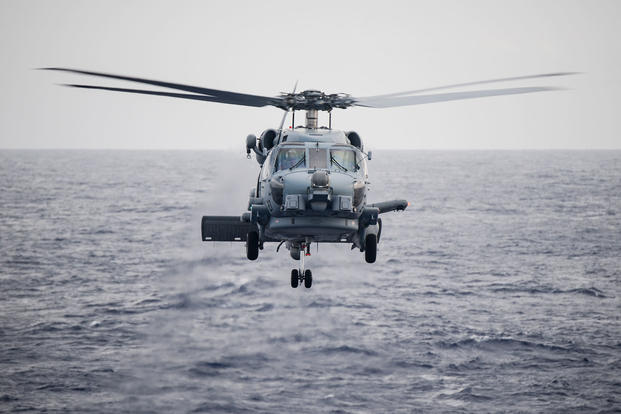A $37.7 million MH-60R Seahawk helicopter that crashed in the water seconds after taking off from the deck of the guided-missile destroyer Dewey last year may have suffered a tail rotor cable tension failure, a newly released investigation into the mishap shows.
The helicopter crashed April 27, 2017, while the Dewey was on a deployment to the Western Pacific with another destroyer, the Sterett. What was to be a routine flight from the deck rapidly went sideways; the three-person crew was able to ditch the aircraft and return to the ship without sustaining any major injuries.
The investigation, overseen by a Navy commander, recommended that all the service's MH-60R squadrons pause to evaluate what happened in the crash to avoid similar mishaps. The probe concluded that a number of administrative errors and oversights may have led to maintainers missing the worn or stressed cable, but stopped short of faulting anyone specifically or recommending discipline.
According to documents released to Military.com through a Freedom of Information Act request, the mishap aircraft was considered a "workhorse" and the most reliable of the two Seahawks assigned to the ship. On April 26, the helicopter had undergone a day of maintenance and testing, concluding with an uneventful functional check flight that wrapped up around 10 p.m.
The next morning started early, with an aircraft launch time of just before 7 a.m. While the Seahawk started without a problem, things went sideways immediately after it lifted off the deck. An officer who had supervised maintenance for the aircraft and observed the launch watched in shock as the helicopter briefly entered a hover 10 feet off the deck, then seemed to yaw crazily to the side.
"Next thing I know, I see the bottom of the Radome directly overhead the [landing signal officer] shack with the aircraft pointing almost 90 degrees off to starboard," the officer told investigators in a statement. "[Another officer] and I both commented something along the lines of, 'What the...?' At that time, I saw the aircraft continue through 90 degrees of turn towards a full 360."
The aircraft rotated a second time and descended behind the ship as sailors on deck sounded the crash alarm. A rigid-hulled inflatable boat, or RHIB, was launched to collect survivors. As those on the ship watched, three people -- the entire helicopter crew -- popped to the surface, where they were quickly recovered and brought back to the ship uninjured.
Inside the aircraft, according to crew statements, there wasn't much time to react. Pilots observed the helicopter behaving oddly after launch, and seconds later were egressing as the aircraft hit the water.
According to the pilot at the controls, the events leading up to the aircraft hitting the water took place in the span of about four seconds. Pedal inputs were "mushy" as the helicopter began to climb, the pilot said, and at first it wasn't clear if the Seahawk couldn't enter a solid hover due to wind effects or some other reason.
"That's weird," the pilot told the crew, just before the aircraft broke to the right and began to enter a spin.
The pilot called "hover hover hover," and the crew started emergency procedures as the aircraft dropped lower toward the water.
"I called 'hover hover hover' once again, knowing that I would soon be so disoriented that I would not be able to fly the spinning aircraft," the pilot recalled to investigators. "I knew Naval Air Training and Operating Procedures Standardization (NATOPS) has a warning that allows me to perform this emergency procedure in this situation. I also knew that it was the only way out of the emergency where everyone had the best chance of survival."
The investigation ultimately found that the pilot would have had to act in seconds to have any chance to save the aircraft. If the pilot had been able to recognize the problem, diagnose the issue, choose to abort the flight and move to land within five to six seconds of takeoff, the Seahawk might have been saved; by seven seconds after takeoff, it was too late.
The cause of the mishap appeared to be a single cable failure "due to elongation and fatigue" that ultimately led to loss of tail rotor control for the aircraft. Investigators, probing with a fine-tooth comb, turned up a number of maintenance errors, including a possible improper installation of another part that may have affected the element that failed, and an incorrect maintenance diagnosis that led to the re-tensioning of already stressed rotor cables.
Investigators found the Seahawk's maintenance team was motivated and conscientious about their work, but also uncovered a number of administrative errors in maintenance records that could have led to other mistakes.
"The [mishap combat element], through an initial lack of understanding of procedures, learned behavior from the community, lack of pristine procedural compliance, and lack of critical data regarding cable tension splits, likely missed two opportunities to discover, diagnose and correct a damaged and failing tail rotor cable system," the investigation concluded, citing two more minor incidents where evidence of a tension split was observed.
The investigation ultimately recommended that all Navy MH-60R squadrons and maintainers who support H-60 aircraft analyze the mishap to determine where they might be at risk of missing a similar high-stakes failure.
-- Hope Hodge Seck can be reached at hope.seck@military.com. Follow her on Twitter at @HopeSeck.










